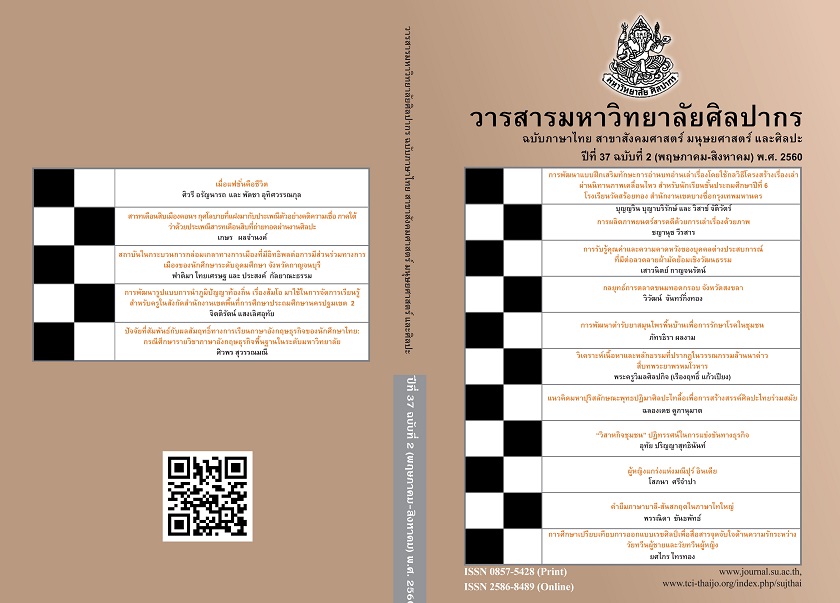สถาบันในกระบวนการกล่อมเกลาทางการเมืองที่มีอิทธิพล ต่อการมีส่วนร่วมทางการเมืองของนักศึกษาระดับอุดมศึกษา จังหวัดกาญจนบุรี (Institutes which Influenced Political Participation of College Students in Kanchanaburi Province)
Main Article Content
Abstract
การวิจัยครั้งนี้มีวัตถุประสงค์เพื่อ 1) ระดับความคิดเห็นของนักศึกษาที่มีต่อสถาบันในกระบวนการกล่อมเกลาทางการเมือง 2) ระดับความคิดเห็นของนักศึกษาที่มีต่อการมีส่วนร่วมทางการเมืองของนักศึกษา 3) ความสัมพันธ์ระหว่างความคิดเห็นของนักศึกษาที่มีต่อสถาบันในกระบวนการกล่อมเกลาทางการเมืองกับความคิดเห็นของนักศึกษาที่มีต่อการมีส่วนร่วมทางการเมืองของนักศึกษา 4) ความคิดเห็นของนักศึกษาที่มีต่อสถาบันในกระบวนการกล่อมเกลาทางการเมืองที่มีอิทธิพลต่อความคิดเห็นของนักศึกษาที่มีต่อการมีส่วนร่วมทางการเมืองของนักศึกษา โดยกลุ่มตัวอย่างคือนักศึกษาระดับอุดมศึกษา จังหวัดกาญจนบุรี จำนวน 379 คน เครื่องมือที่ใช้ในการเก็บข้อมูลเป็นแบบสอบถาม ซึ่งหาค่าความเชื่อมั่นทั้งฉบับได้เท่ากับ 0.910 สถิติที่ใช้ในการวิเคราะห์ข้อมูล ได้แก่ ค่าร้อยละ ค่าเฉลี่ย ส่วนเบี่ยงเบนมาตรฐาน ค่าสัมประสิทธิ์สหสัมพันธ์เพียร์สัน และการวิเคราะห์การถดถอยพหุคูณแบบขั้นตอนพหุคูณโดยมีค่านัยสำคัญทางสถิติที่ระดับ .05
ผลการวิจัยพบว่า 1) ระดับความคิดเห็นของนักศึกษาที่มีต่อสถาบันในกระบวนการกล่อมเกลาทางการเมืองในภาพรวม อยู่ในระดับปานกลาง (x̄ = 3.13, S.D. = 0.87) 2) ระดับความคิดเห็นของนักศึกษาที่มีต่อการมีส่วนร่วมทางการเมืองในภาพรวมอยู่ในระดับปานกลาง (x̄ = 3.26, S.D.= 0.61) 3) ความคิดเห็นของนักศึกษาที่มีต่อสถาบันในกระบวนการกล่อมเกลาทางการเมืองในภาพรวมมีความสัมพันธ์ทางบวกกับ ความคิดเห็นของนักศึกษาที่มีต่อการมีส่วนร่วมทางการเมือง (r = .823, p < 0.05) อยู่ในระดับสูงมาก 4) ความคิดเห็นของนักศึกษาที่มีต่อสถาบันในกระบวนการกล่อมเกลาทางการเมือง สามารถอธิบายความผันแปรของความคิดเห็นของนักศึกษาที่มีต่อการมีส่วนร่วมทางการเมืองได้ ร้อยละ 67.7 อย่างมีนัยสำคัญทางสถิติที่ระดับ .05 (R2 = .677) และมีค่า R2 ที่ปรับค่าแล้วร้อยละ 67.6 (R2adj = .676) โดยมีความคลาดเคลื่อนมาตรฐานในการพยากรณ์เท่ากับ .373 (Std. Error =.373) อย่างมีค่านัยสำคัญทางสถิติที่ระดับ .05 และ การมีส่วนร่วมทางการเมืองสามารถอธิบายความผันแปรของ ความคิดเห็นของนักศึกษาที่มีต่อการมีส่วนร่วมทางการเมืองได้ดีที่สุดซึ่ง ได้แก่ 1) ด้านกลุ่มเพื่อน (β = .432) 2) กลุ่มสื่อมวลชน (β = .374) 3) ด้านครอบครัว (β = .127) 4) ด้านสถาบันการศึกษา (β = .063) อย่างมีนัยสำคัญทางสถิติที่ระดับ .05
Downloads
Article Details
References
Boonbongkan, S. (1994). Thai Political Development: Interaction Between Soldiers Political institutions And the political participation of the people. Bangkok: Chulalongkorn University.
Chumphon, P. (1992). Political regime: basic knowledge. Bangkok: Chulalongkorn University.
Kanchanasuwan, W. (2001). Political culture Politics Constitution of the people. (2nd ed.). Bangkok: VJ Printing.
Lipset, S. M. 1960. Politican Man: The Social Bases of Politics. New York: Doubleday & Company, Inc.
Milbrath, L. W. and Goel, M. L. (1977). Political Participation: How and Why Do People Get. New York: Doubleday & Company, Inc.
Nakata, T. (2000). Political administrationNational burden. Bangkok: Companion Blog and Printing.
Pensiri, K. (2004). The political participation of people in Khlong Toei district The local form of Bangkok Metropolis. Political Science. Kasetsart University.
Pongpaw, P. and Suktipan, S. (1983). Children's politics Social process.Bangkok Metropolis: Chao Phraya Printing.
Poojaroen, S. (2004). The Political Transformation of the University Students in Payap Chiang Mai Province ,Chiang Mai University Political Science, Chiang Mai: Chiang Mai University.
Samsem, P. (2008). The political participation of the people in Tambon Municipality Amphoe Mueang Ratchaburi. Master of Arts Thesis Political Science Chom Bueng Rajabhat University.
Suksan, S. (2009). Political Participation of People in Mueang Uttaradit Municipality. Master Thesis, Uttaradit Rajabhat University, Uttaradit, Thailand.
Thitiwatana, P. (1999). Women's Development Bangkok: Agricultural Cooperatives FederationOf Country Limited.
Yamane, T. (1967). Statistics; An Introductory Analysis. New York: Harper and Row.


